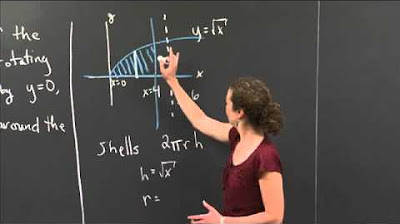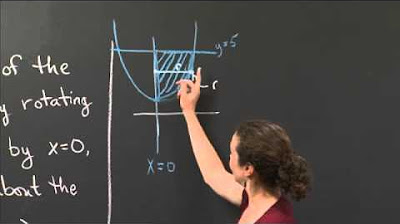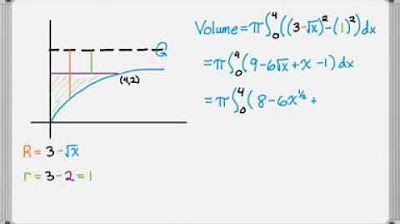Computing the Volume of a Paraboloid | MIT 18.01SC Single Variable Calculus, Fall 2010
TLDRIn this recitation video, the professor guides students through calculating the volume of a paraboloid formed by rotating the curve y = x^2 around the y-axis. The process begins with approximating the volume using Riemann sums and cylinders, then transitions to an integral in the y variable. By integrating from 0 to H, the height of the paraboloid, the volume is found to be proportional to pi times H squared, offering a clear demonstration of the application of calculus in volume calculations.
Takeaways
- 📚 The lecture is focused on finding the volume of a paraboloid using Riemann sums and integrals.
- 📐 The paraboloid is formed by rotating the curve y = x^2 around the y-axis from 0 to a height H.
- 🤔 The students are encouraged to think about how to express the volume as an integral, preferably in terms of y.
- 🔍 The initial approach is to break the paraboloid into cylinders for an estimation using Riemann sums.
- 📏 The cylinders' heights are evenly divided with a constant delta y, and the radius at height y is the square root of y.
- 🧩 The volume of each cylinder is calculated as pi times the square of the radius (y) times the height (delta y).
- ∑ The Riemann sum is represented as a sum of the volumes of these cylinders from i=1 to n, with each y value at different heights.
- 📉 As the number of subintervals (n) increases, the cylinders become flatter, providing a better approximation of the paraboloid's volume.
- 🔗 The limit as n approaches infinity turns the Riemann sum into an integral, with delta y becoming dy.
- ∫ The integral representation of the volume is pi times the integral of y with respect to y from 0 to H.
- 📝 The integral can be evaluated to find the volume, which is approximately pi over 2 times the square of the height H.
- 📈 The final volume formula derived is pi * H^2 / 2, showcasing the volume enclosed by the rotation of y = x^2 around the y-axis.
Q & A
What is the main topic of the video?
-The main topic of the video is to find the volume of a paraboloid formed by rotating the curve y = x^2 around the y-axis using Riemann sums and integrals.
What is the curve that is rotated around the y-axis to form the paraboloid?
-The curve that is rotated around the y-axis to form the paraboloid is y = x^2.
Why is it suggested to integrate in the y variable instead of the x variable?
-It is suggested to integrate in the y variable because the paraboloid's volume is more naturally expressed in terms of y, considering the rotation around the y-axis and the symmetry of the problem.
How does the professor initially estimate the volume of the paraboloid?
-The professor initially estimates the volume of the paraboloid by breaking it up into four cylinders and calculating the volume of each cylinder.
What is the height of each cylinder in the initial estimation?
-The height of each cylinder in the initial estimation is delta y, which is the change in y and is assumed to be constant for the first approximation.
How is the radius of the cylinders related to the height y?
-The radius of the cylinders is related to the height y by the equation r^2 = y, which means the radius is the square root of y.
What is the formula for the volume of a single cylinder used in the estimation?
-The formula for the volume of a single cylinder used in the estimation is V = π * r^2 * h, where r is the radius and h is the height of the cylinder.
How does the professor refine the approximation of the paraboloid's volume?
-The professor refines the approximation by dividing the paraboloid into more subintervals, making the cylinders flatter and thus getting better estimates of the volume, which in the limit becomes the volume of the paraboloid.
What is the final integral representation of the volume of the paraboloid?
-The final integral representation of the volume of the paraboloid is ∫ from 0 to H of π * y * dy.
What is the result of evaluating the integral for the volume of the paraboloid?
-The result of evaluating the integral for the volume of the paraboloid is approximately (π/2) * H^2, assuming the integral is correctly evaluated.
How does the process described in the video relate to Riemann sums?
-The process described in the video relates to Riemann sums by approximating the volume under a curve (in this case, the volume of the paraboloid) by summing the volumes of rectangles (or cylinders) and then taking the limit as the number of rectangles goes to infinity.
Outlines
📚 Introduction to Calculating Paraboloid Volume
The professor begins the recitation by introducing the task of finding the volume of a paraboloid formed by rotating the curve y = x^2 around the y-axis. The focus is on using Riemann sums and integrals to solve the problem. Students are encouraged to think about setting up the volume as an integral with respect to the y variable rather than x. The process starts with a basic understanding of the paraboloid's formation and a visual estimation using four cylinders to approximate the volume, which will later be refined using calculus.
📈 Transition from Riemann Sums to Definite Integral
The professor continues by explaining how to refine the volume estimation by dividing the paraboloid into more subintervals, using an increasing number of cylinders to approximate its shape. As the number of subintervals (n) approaches infinity, the Riemann sum converges to a definite integral. The integral to find the volume of the paraboloid is derived, which is the integral from 0 to H of pi*y*dy. The professor provides a brief insight into the integration process and suggests the final result, which is pi over 2 times the square of the height H, offering a clear example of applying calculus to a geometric problem.
Mindmap
Keywords
💡Paraboloid
💡Riemann Sums
💡Integrals
💡Rotation around the y-axis
💡Volume
💡Cylinders
💡Height (H)
💡Radius (r)
💡Delta y
💡Limit
💡Square root
Highlights
Introduction to finding the volume of a paraboloid using Riemann sums and integrals.
Explanation of the paraboloid formed by rotating the curve y = x^2 around the y-axis.
Suggestion to integrate in the y variable rather than x for calculating the volume.
Approach to estimate volume using Riemann sums by breaking the paraboloid into cylinders.
Illustration of dividing the paraboloid into four initial cylinders for volume estimation.
Discussion on improving approximations by making cylinders flatter as they approach the limit.
Relation of the process to Riemann sums and the volume of pyramids problem.
Calculation of the volume of a single cylinder using pi, y (height), and delta y.
Expression of the volume of the paraboloid as a sum of volumes of cylinders for different heights.
Transition from Riemann sum to integral by dividing into n subintervals and letting n approach infinity.
Derivation of the integral representation of the volume of the paraboloid as ∫(pi*y*dy) from 0 to H.
Evaluation of the integral to find the volume of the paraboloid as pi*H^2/2.
Application of the method to the specific curve y = x^2 and height H.
Conclusion summarizing the volume calculation of the paraboloid formed by y = x^2.
Emphasis on the importance of understanding the process and checking the math for accuracy.
Encouragement for students to apply this method to other similar problems.
Transcripts
Browse More Related Video

Disc method around x-axis | Applications of definite integrals | AP Calculus AB | Khan Academy

Volume of Revolution via Shells | MIT 18.01SC Single Variable Calculus, Fall 2010

Disc method around y-axis | Applications of definite integrals | AP Calculus AB | Khan Academy

Volume of a Paraboloid via Disks | MIT 18.01SC Single Variable Calculus, Fall 2010

Solid of Revolution (part 4)

Volume of Revolution Examples - Horizontal Axis
5.0 / 5 (0 votes)
Thanks for rating: